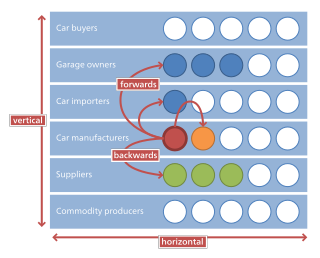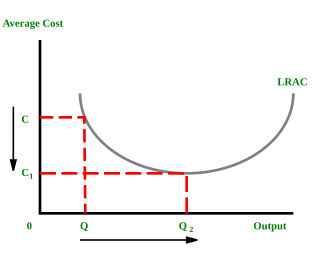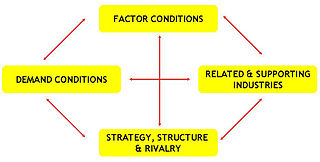Vertical disintegration refers to a specific organizational form of industrial production. As opposed to vertical integration, in which production occurs within a singular organization, vertical disintegration means that various diseconomies of scale or scope have broken a production process into separate companies, each performing a limited subset of activities required to create a finished product.

In microeconomics and management, vertical integration is an arrangement in which the supply chain of a company is owned by that company. Usually each member of the supply chain produces a different product or (market-specific) service, and the products combine to satisfy a common need. It is contrasted with horizontal integration, wherein a company produces several items which are related to one another. Vertical integration has also described management styles that bring large portions of the supply chain not only under a common ownership, but also into one corporation.
Filmed entertainment was once highly vertically integrated into a studio system whereby a few large studios handled everything from production to theatrical presentation. After the second world war, the industry was broken into small fragments, each specializing on particular tasks within the division of labor required to produce and show a finished piece of filmed entertainment. Hollywood became highly vertically disintegrated, with specialized firms who only performed certain tasks such as editing, special effects, trailers etc. Bell System divestiture had a similar effect on a larger industry later in the 20th century.
The studio system is a method of film production and distribution dominated by a small number of "major" studios in Hollywood. Although the term is still used today as a reference to the systems and output of the major studios, historically the term refers to the practice of large motion picture studios between the 1920s and 1960s of (a) producing movies primarily on their own filmmaking lots with creative personnel under often long-term contract, and (b) dominating exhibition through vertical integration, i.e., the ownership or effective control of distributors and exhibition, guaranteeing additional sales of films through manipulative booking techniques such as block booking.

The cinema of the United States, often metonymously referred to as Hollywood, has had a large effect on the film industry in general since the early 20th century. The dominant style of American cinema is classical Hollywood cinema, which developed from 1917 to 1960 and characterizes most films made there to this day. While Frenchmen Auguste and Louis Lumière are generally credited with the birth of modern cinema, American cinema soon came to be a dominant force in the industry as it emerged. It produces the total largest number of films of any single-language national cinema, with more than 700 English-language films released on average every year. While the national cinemas of the United Kingdom (299), Canada (206), Australia, and New Zealand also produce films in the same language, they are not considered part of the Hollywood system. Hollywood has also been considered a transnational cinema. Classical Hollywood produced multiple language versions of some titles, often in Spanish or French. Contemporary Hollywood offshores production to Canada, Australia, and New Zealand.
One major reason for vertical disintegration is to share risk. Also, in some cases, smaller firms can be more responsive to changes in market conditions. Vertical disintegration is thus more likely when operating in volatile markets. Stability and standardized products more typically engender integration, as it provides the benefits of scale economies.
The geography of a disintegrated industry is not a given. Economic geographers typically differentiate between knowledge-intensive, volatile, unstandardized activities, and standardized, routinized production. The former tend to be clustered in space, as they require proximity to build a common conceptual framework and share new ideas. The latter can be far flung and are exemplified by global commodity chains such as apparel and automotive industries. Even in those industries however, design and other creative and non-repetitive tasks tend to exhibit some geographical clustering.
Economic geography has been defined by the geographers as the study of human's economic activities under varying sets of conditions which is associated with production, location, distribution, consumption, exchange of resources, and spatial organization of economic activities across the world. It represents a traditional subfield of the discipline of geography. However, many economists have also approached the field in ways more typical of the discipline of economics.
A number of commentators have remarked that in the Internet age commodity chains are becoming increasingly more transparent. The Wikichains.org project has adopted the same wiki technology used by Wikipedia in order to help make commodity chains more transparent. "They are a network of labour and production processes whose end result is a finished commodity". William Jones Esq.
A business cluster is a geographic concentration of interconnected businesses, suppliers, and associated institutions in a particular field. Clusters are considered to increase the productivity with which companies can compete, nationally and globally. In urban studies, the term agglomeration is used. Clusters are also important aspects of strategic management.




